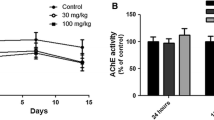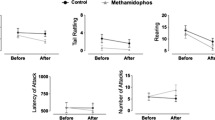Abstract
The effects on behavior and cholinesterase (ChE) of an OP pesticide, dimethoate, were examined in wood mice under laboratory conditions. Mice were administered 0, 5, 15, or 50 mg/kg intraperitoneal dimethoate and their behavior was recorded in an open field for one hour. In a second experiment, using only the 0 and the 50 mg/kg dose, mice were subjected to 10-min open field tests repeated at various time intervals during a 24-h period. Shortly after administration of dimethoate, there was a general, dose-dependent, behavioral depression that was characterized by increased inactivity and decreased grooming, rearing, and sniffing. The introduction of a novel object in the open field failed to elicit any reaction in mice treated with the two highest doses of dimethoate. The behavioral impairment completely disappeared 6 h after treatment. A stereotyped compulsive grooming was also observed in the first 30 min after administration of the two highest doses. Exposure to dimethoate caused a dose-dependent decrease in ChE activity in the brain and in serum. Behavioral impairment was associated with maximum levels of ChE inhibition of 65–75% (brain) and 75–85% (serum). Recovery of ChE activity lagged behind that of behavioral impairment and started 3–6 h after dimethoate administration. The possible implications for free-living wood mice which inhabit cereal fields and may be exposed to OPs are discussed.
Similar content being viewed by others
References
Banks A, Russell RW (1967) Effects of chronic reductions in acetylcholinesterase activity on serial problem-solving behavior. J Comp Physiol Psychol 64:262–267
Benke GM, Murphy SD (1974) Anticholinesterase action of methyl parathion, parathion and azinphosmethyl in mice and fish: Onset and recovery of inhibition. Bull Environ Contam Toxicol 12:117–122
Bignami G, Giardini V, Scorrano M (1985) Behaviorally augmented versus other components in organophosphate tolerance: The role of reinforcement and response factors. Fundam Appl Toxicol 5:s213-s224
Bignami G, Rosić N, Michalek H, Milošević M, Gatti GL (1975) Behavioral toxicity of anticholinesterase agents: Methodological, neurochemical, and neuropsychological aspects. In: Weiss B, Laties VG (eds) Behavioral Toxicology. Plenum, NY, pp 155–210
Dauterman WC, Casida JE, Knaak JB, Kowalczyk T (1959) Bovine metabolism of organophosphorus insecticides. Metabolism and residues associated with oral administration of dimethoate to rats and three lactating cows. J Agric Food Chem 7:188–193
Fishwick SK, Shore RF, Turk A, Sparks TH (1996) Variation of brain and serum cholinesterase activity with age in wild small mammals. Bull Environ Contam Toxicol 56:604–611
Giardini V, Meneguz A, Amorico L, De Acetis L, Bignami G (1982) Behaviourally augmented tolerance during chronic cholinesterase reduction by paraoxon. Neurobehav Toxicol Teratol 4:335–345
Greig-Smith PW (1991) Use of cholinesterase measurements in surveillance of wildlife poisoning in farmlands. In: Mineau P (ed) Cholinesterase-inhibiting insecticides, their impact on wildlife and the environment. Elsevier, Amsterdam, pp 127–150
Grue CE (1982) Response of common grackles to dietary concentrations of four organophosphate pesticides. Arch Environ Contam Toxicol 11:617–626
Grue CE, Fleming WJ, Busby DG, Hill EF (1983) Assessing hazards of organophosphate pesticides to wildlife. Trans North Am Wildl Nat Resour Conf 48:200–220
Hardy AR, Westlake GE, Lloyd GA, Brown PM, Greig-Smith PW, Fletcher MR, Tarrant KA, Stanley PI (1993) An intensive field trial to assess hazards to birds and mammals from the use of methiocarb as a bird repellent of ripening cherries. Ecotoxicology 2:1–31
Hart ADM (1993) Relationships between behavior and the inhibition of acetylcholinesterase in birds exposed to organophosphorus pesticides. Environ Toxicol Chem 12:321–336
Johnson IP, Florwerdew IR, Hare R (1991) Effects of broadcasting and of drilling methiocarb molluscicide pellets on field populations of wood mice, Apodemus sylvaticus. Bull Environ Contam Toxicol 46:84–91
Mason GJ (1991) Stereotypies: A critical review. Anim Behav 41:1015–1037
McEwen FL, Stephenson GR (1979) The use and significance of pesticides in the environment. Wiley J & Sons, NY
Metz B (1958) Brain cholinesterase and a respiratory reflex. Amer J Physiol 192:101–105
Peakall DB (1985) Behavioral responses of birds to pesticides and other contaminants. Residue Rev 96:45–77
Rattner BA, Fairbrother A (1991) Biological variability and the influence of stress on cholinesterase activity. In: Mineau P (ed) Cholinesterase-inhibiting insecticides, their impact on wildlife and the environment. Elsevier, Amsterdam, pp 89–107
Rattner BA, Hoffman DJ (1984) Comparative toxicity of acephate in laboratory mice, white-footed mice, and meadow voles. Arch Environ Contam Toxicol 13:483–491
Reddy BN, Reddy KSS, Janardhan A (1991) Effect of dimethoate and fenvalerate on conditioned avoidance and passive avoidance responses. Indian J Exp Biol 29:176–177
Russell RW, Warburton DM, Segal DS (1969) Behavioural tolerance during chronic changes in the cholinergic system. Commun Behav Biol 4:121–128
Sanderson DM, Edson EF (1964) Toxicological properties of the organophosphorus insecticide dimethoate. Dr J Ind Med 21:52–64
Sermons AL, Ross FH, Walker CA (1980) 24 h toxicity rhythms of sedative hypnotic drug in mice. Arch Toxicol 45:9–14
Shore RF, Douben PET (1994) Predicting ecotoxicological impacts of environmental contaminants on terrestrial small mammals. Rev Environ Contam Toxicol 134:49–89
Tarrant KA, Westlake GE (1988) Laboratory evaluation of the hazard to wood mice, Apodemus sylvaticus, from the agricultural use of methiocarb molluscicide pellets. Bull Environ Contam Toxicol 40:147–152
Tew TE, McDonald DW (1994) Dynamics of space use and male vigour amongst wood mice, Apodemus sylvaticus, in the cereal ecosystem. Behav Ecol Sociobiol 34:337–345
Thompson HM (1991) Serum “B” esterases as indicators of exposure to pesticides. In: Mineau P (ed) Cholinesterase-inhibiting insecticides, their impact on wildlife and the environment. Elsevier, Amsterdam, pp 127–150
Westlake GE, Blunden PM, Brown PM, Bunjan PJ, Martin AD, Sayers PE, Stanley PI, Tarrant KA (1980) Residues and effects in mice after drilling wheat treated with chlorfenvinphos and an organomercurial fungicide. Ecotoxicol Environ Safety 4:1–16
Westlake GE, Bunyan PJ, Johnson JA, Martin AD, Stanley PI (1982) Biochemical effects in mice following exposure to wheat treated with chlorfenviphos and carbophenothion under laboratory and field conditions. Pestic Biochem Physiol 18:49–56
Westlake GE, Martin AD, Stanley PI, Walker CH (1983) Control enzyme levels in the plasma, brain and liver from wild birds and mammals in Britain. Comp Biochem Physiol 76C:15–24
Wilcox RR (1987) New statistical procedures for the social sciences. Erlbaum, Hillsdale, NJ
Wison IB, Cohen M (1953) Essentiality of acetylcholinesterase in conduction. Biochem Biophys Acta 11:147–156
Author information
Authors and Affiliations
Rights and permissions
About this article
Cite this article
Dell'Omo, G., Shore, R.F. Behavioral and physiological effects of acute sublethal exposure to dimethoate on wood mice, Apodemus sylvaticus [I—Laboratory studies]. Arch. Environ. Contam. Toxicol. 31, 91–97 (1996). https://doi.org/10.1007/BF00203912
Received:
Revised:
Issue Date:
DOI: https://doi.org/10.1007/BF00203912




